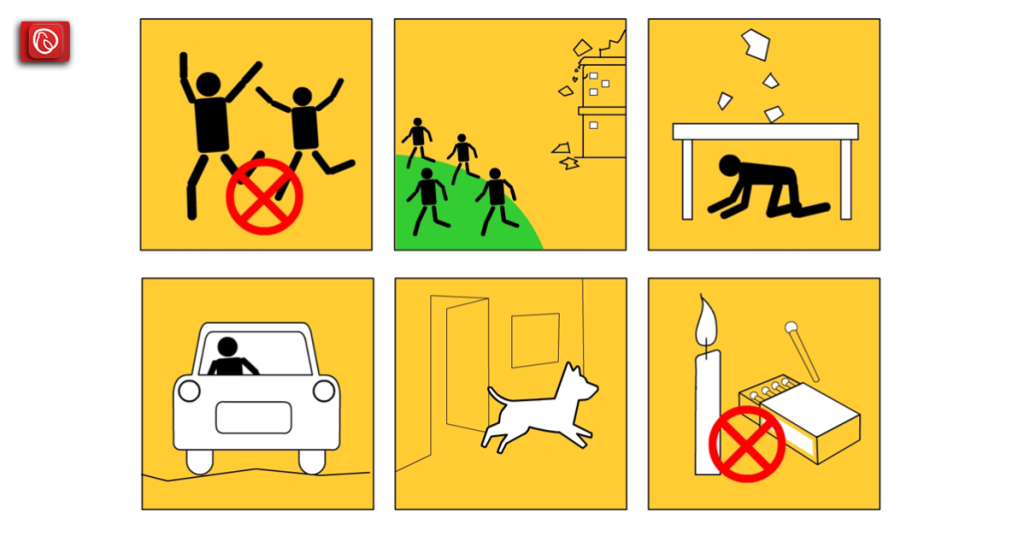Did you know that nearly half of all Americans reside in areas with a significant risk of experiencing a potentially destructive earthquake? While many assume that seismic activity is mostly confined to the western United States, the reality is far broader.
According to the American Red Cross, 45 states and U.S. territories are classified as having a “moderate to very high” risk of earthquakes.
Unlike other natural disasters such as wildfires or hurricanes—which often come with advance warnings—earthquakes strike without notice, leaving little to no time for evacuation or preparation.
This unpredictability makes earthquake preparedness not just important, but essential. Here’s what every household should know.
Read More: Earthquake Preparedness: Essential Safety Strategies for Protecting Your Home and Family
Evaluate Your Earthquake Risk
Begin by determining whether you live in an earthquake-prone area. The Federal Emergency Management Agency’s Earthquake Hazard Map offers a helpful starting point for assessing regional seismic risks. Once you’ve gathered this information, have an open discussion with your family.
Help them understand that earthquakes can occur without any warning, unlike other natural disasters. This unpredictability makes proactive planning and awareness critical.
Rehearse Earthquake Safety Procedures
Preparedness can save lives. According to Ready.gov, the recommended course of action during an earthquake is to “Drop, Cover, and Hold On.” Here’s how to practice that effectively:
Drop to your hands and knees to prevent being knocked over.Cover your head and neck with your arms. If possible, crawl under a sturdy piece of furniture for added protection. If no shelter is available, move next to an interior wall—away from windows—to reduce the risk of injury from shattered glass.
Hold On to a table or furniture leg to remain sheltered during the shaking.
Strengthen Your Home’s Earthquake Readiness
To safeguard your household, begin by reinforcing your home’s interior. Anchor heavy furniture, appliances, and water heaters to the wall to prevent tipping. Secure any hanging items such as mirrors, televisions, and artwork.
Avoid placing these above beds or seating areas to reduce the risk of injury during shaking. Keep heavy objects on lower shelves to minimize falling hazards. Additionally, consider your financial protection—standard homeowners or renters insurance typically does not include earthquake coverage.
Talk to your insurance provider about adding a dedicated earthquake policy to ensure you’re adequately covered.
Establish a Family Communication Plan
Earthquakes can strike without warning, and your family may not be together when it happens. That’s why it’s crucial to develop a communication strategy in advance. Designate an out-of-state emergency contact for everyone to check in with, as local phone lines may be overwhelmed or offline.
Encourage family members to use text messaging, which can often get through when voice calls can’t. Reviewing and practicing this plan regularly ensures that everyone knows how to stay connected and safe if separated during an emergency.
Build and Maintain an Emergency Kit
A well-stocked emergency kit is essential for earthquake preparedness. It should include at least three days’ worth of non-perishable food, drinking water, medications, first aid supplies, and personal hygiene items.
Also include flashlights, extra batteries, a multi-purpose tool, masks, and sanitation products. Ready.gov offers a comprehensive checklist to help you prepare. To stay prepared wherever you are, consider placing smaller versions of your emergency kit in your car, workplace, and children’s backpacks.
Know What to Do After the Shaking Stops
The risk doesn’t end when the ground stops moving. Aftershocks can follow minutes or even days later and may cause additional damage. Stay where you are if the structure is safe; if not, exit cautiously, avoiding buildings and downed power lines.
If you find yourself trapped, signal for help by banging on walls or using a whistle or flashlight. If possible, send a text message to emergency services or loved ones to alert them to your location.
Once safe, log on to the American Red Cross’s “Safe and Well” website to mark yourself safe and search for others who may need help.
Review Your Insurance Coverage
Earthquake coverage is not part of a standard homeowners or renters insurance policy, so it’s critical to purchase it separately. Speak to your insurance carrier to understand the terms and costs, particularly how deductibles work.
Instead of a flat rate, earthquake deductibles are often calculated as a percentage—usually between 2% and 20%—of your home’s replacement value. Knowing these details beforehand can make a significant difference in your recovery process after a disaster.
Frequently Asked Questions (FAQs)
How can I tell if I live in an earthquake-prone area?
You can check the earthquake hazard map provided by the Federal Emergency Management Agency (FEMA) or consult your local emergency management office. According to the American Red Cross, 45 U.S. states and territories are considered at moderate to very high risk of earthquakes.
Are doorways safe places to stand during an earthquake?
No. Contrary to old beliefs, doorways are not safer than other parts of your home. Modern building codes make most parts of a home equally stable. It’s safer to shelter under a sturdy table or desk.
Should I prepare multiple emergency kits?
Yes. It’s a good idea to have smaller emergency kits stored in your car, workplace, and school bags in case you are not at home when an earthquake strikes.
What if my family is separated during an earthquake?
Create a family communication plan. Designate an out-of-state contact person everyone can call or text to check in. Local lines are often overloaded, but text messages can usually get through.
Is earthquake damage covered by homeowners insurance?
No. Standard homeowners and renters policies do not cover earthquake damage. You’ll need to purchase a separate earthquake insurance policy. Be sure to understand how the deductible works—typically, it’s calculated as a percentage of your home’s replacement value.
What should I do after an earthquake ends?
Stay alert for aftershocks. If you’re safe where you are, stay put. If your building is damaged, exit cautiously and stay clear of debris and power lines. Once safe, check in with loved ones and register on the American Red Cross’s “Safe and Well” website to let others know you’re okay.
How often should I update my emergency supplies?
Review your emergency kits every six months. Replace expired food, batteries, medications, and update items based on your family’s changing needs, such as baby supplies or pet food.
Conclusion
Earthquakes can strike without warning, leaving little to no time for last-minute decisions. That’s why preparedness is not optional—it’s essential. By understanding your regional risk, practicing safety drills, securing your home, and having a communication and emergency plan in place, you significantly increase your chances of keeping yourself and your loved ones safe.

